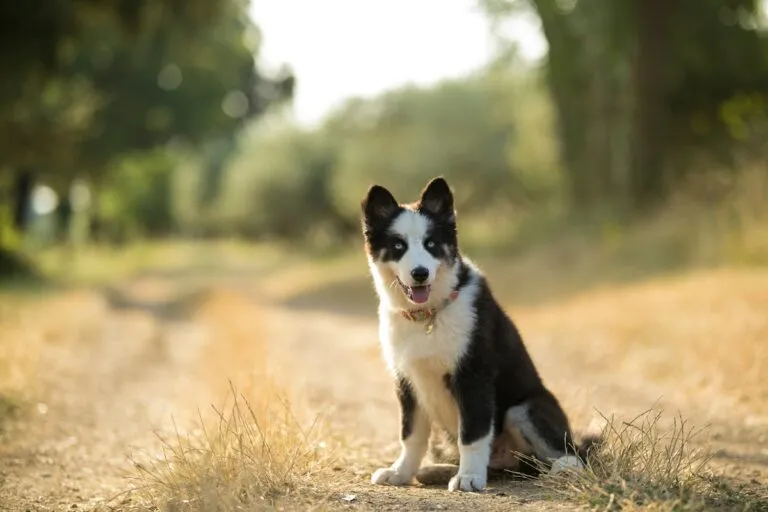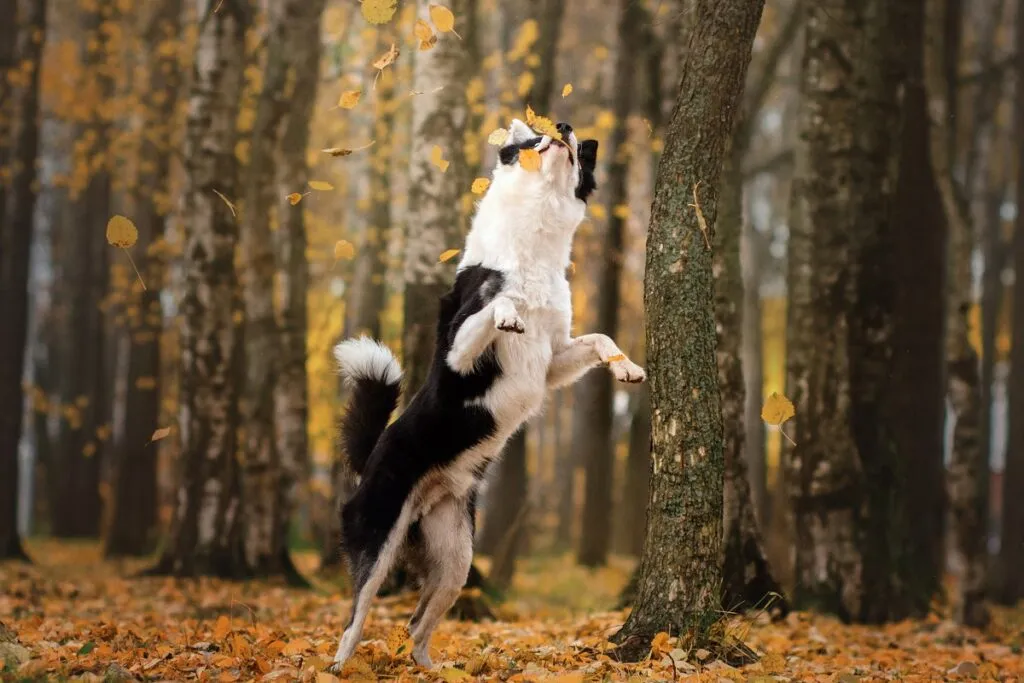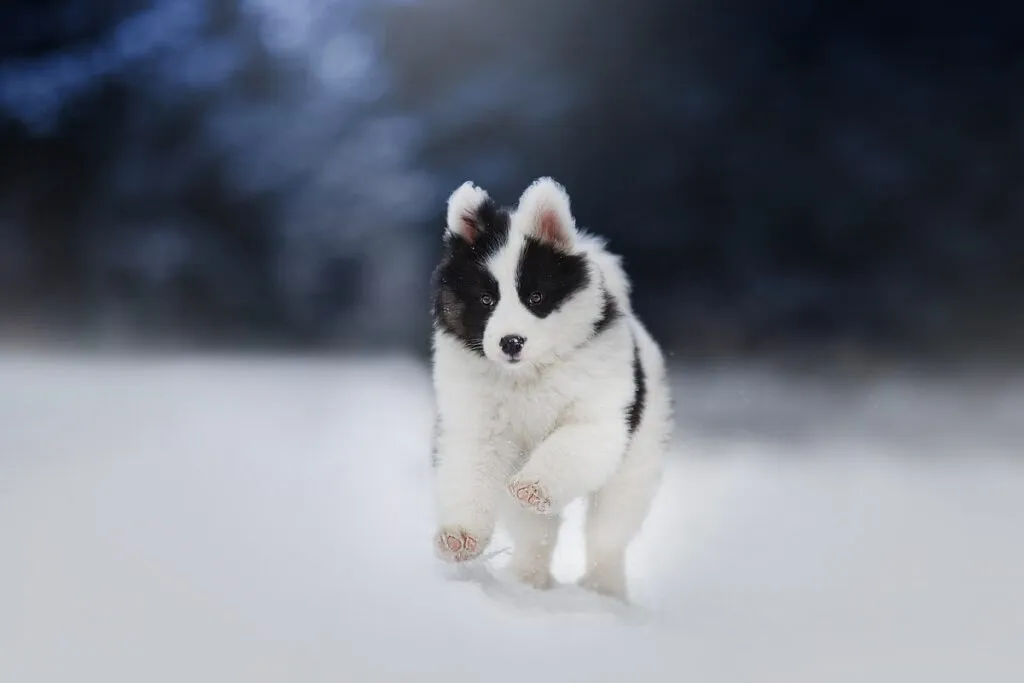Medium Size Poodle
The Yakutskaya Laika, also known as the Yakutian Laika or Kolyma-Indigirka Laika, is an ancient sled dog breed from the Russian region of Yakutia. It is considered one of the progenitors of the Siberian Husky, which was developed using Yakutskaya Laikas imported to Alaska during its breeding development.

© melounix / stock.adobe.com
With its pointed ears and wedge-shaped head, the Yakutskaya Laika resembles a polar wolf.
The Yakutskaya Laika is a very strong and compact dog of medium size. The breed is classified under Group 5 “Spitz and Primitive Types”.
Males have a withers height of 55 to 59 centimetres, while females measure about 53 to 57 centimetres. The weight is not specified by the breed standard but usually ranges between 20 and 23 kilograms.
Visually, this Nordic dog resembles a polar wolf. Its head is wedge-shaped, with erect or slightly tipping ears set high and furry on the inside. The Yakutskaya Laika’s wide-set, almond-shaped eyes are brown or blue, with heterochromia also being present.
Beneath its dense, glossy top coat lies a thick warming undercoat. Tufts of hair grow between its toes. The legs have feathering, and the curled rod is covered with bushy fur.
Around the neck, the Yakutskaya Laika sports a plush mane, which is typically more pronounced in males. The coat colour is solid white or white with patches.
Patchwork can be of any colour: from black to brown, grey, and red. Besides solid and bicolour, there are also tricolour Yakutskaya Laikas. Some have lighter facial markings or a dark mask.
 © Kate / stock.adobe.com
© Kate / stock.adobe.com
Its Arctic homeland and historical roles as hunting, herding, and sled dog have shaped the temperament of the Yakutian Laika. The animals are lively, courageous bundles of energy with great endurance.
As sociable sled dogs, they appreciate living in a pack and behave cooperatively towards their pack members.
In cohabitation with humans, this four-legged friend is amiable and affable. It bonds closely with its owner. Yakutskaya Laikas that are sufficiently exercised can be good family dogs. They easily integrate into the hierarchy and are gentle with children.
Like many other Nordic Spitz breeds, the Yakutian Laika tends to be vocal. While it does like to bark, its relatively moderate territorial behaviour doesn’t necessarily make it an effective guard dog.
The Yakutskaya Laika has a strong desire for freedom and a pronounced prey drive. To offer this willing hunting and sled dog a species-appropriate life, regular exercise to tire it out is necessary. Running and pulling are among its favourite activities, making canicross suitable for the breed.
Athletic people can accompany the quick Northern Light while riding, jogging, skiing, and skating. Yet, its intelligent mind and keen nose also require stimulation. Through creative intelligence games and scent work, the Yakutskaya Laika can demonstrate its cleverness.
Its thick, warming coat makes the Yakutian Laika perfectly adapted to the Arctic climate of its Siberian homeland. The summers in more southern areas can become problematic for the breed.
During high temperatures, it’s crucial to provide cooling – for instance, with cooling mats or a dog pool.
The dense coat of the Yakutskaya Laika should be brushed once a week. During the moulting period, coat care should become a daily task on its owner’s to-do list.
Good to know: Brushing distributes an oily film over the hair, which acts as a water repellent and gives the coat a beautiful shine.
The Yakutian Laika needs protein-rich food. It is not accustomed to grains and vegetables, as no agriculture can be conducted on the permafrost soils of its northern Russian homeland.
This dog breed can’t digest carbohydrates in the form of legumes and grain due to the lack of an enzyme that breaks down the contained starch.
Therefore, wet food with a high percentage of vegetables or wheat, dry food, and snacks containing grain are not suitable for this Nordic breed. Instead, high-quality dog food with a high meat content should be fed. Alternatively, biologically appropriate raw feeding, or BARF, is a choice for the dog.
The Yakutian Laika is generally a healthy breed. The sometimes harsh living conditions of its North Siberian homeland have resulted in only the strongest individuals surviving and reproducing.
However, hereditary diseases are occasionally seen in breeds propagated abroad.
This dog breed can be prone to elbow and hip dysplasia. Cancer, particularly colon cancer, is also a common ailment.
Animals with white fur and blue eyes have an increased risk for deafness and hereditary eye diseases.
The average life span of this resilient hunting and sled dog is about 12 years. Adequate exercise and a species-appropriate diet with high protein content significantly contribute to the Yakutian Laika’s health.
The Yakutian Laika has been owned by the peoples of Northeast Siberia since ancient times. Archaeological findings confirm that these thrifty quadrupeds lived in the Yakutia region 8,000 years ago.
The alternative name Kolyma-Indigirka Laika comes from the two large rivers of its homeland.
The indigenous people used these dogs for hunting and as sled dogs, and also as herding dogs for reindeer flocks. In times of need, they served as a source of meat and were used in religious ceremonies as offerings.
In the early 20th century, various sled dog breeds of Siberian peoples were brought to Alaska, including the Yakutskaya Laika. With these animals, the Norwegian dog sled driver Leonhard Seppala founded the breeding of the Siberian Husky.
With advancing industrialisation, the importance of the Yakutian Laika in its Russian homeland waned: traditional dog sleds were increasingly replaced by modern snowmobiles for cargo transport.
In the ’90s, the breed was considered to be at risk of extinction. However, dedicated breeders were able to secure its preservation.
Only at the end of the ’50s was a detailed description of the Nordic dog breed written. Since 2005, there has been an official breed standard set by the Russian Kennel Club.
In 2019, the Yakutskaya Laika was eventually provisionally recognised by the canine umbrella organisation FCI.
 © Nikol / stock.adobe.com
© Nikol / stock.adobe.com
Outside of Russia, the Yakutskaya Laika is not very widespread. For example, the first breeding dogs were brought to Germany only in 2002. Those who have lost their heart to this original Siberian breed should look out for a reputable breeder.
This should be a member of an official association and only release puppies with valid papers. The price for a healthy puppy of this rare breed is usually at least £1,250, without taking into account transport costs into the UK.
Besides the Yakutskaya Laika, the Russian-European Laika, the East- and West Siberian Laika are grouped together under the collective term “Laika”. All mentioned breeds have specific characteristics and needs – but definitely have the potential to excite fans of Nordic Spitz.
Those who would like to keep a sled dog could consider breeds such as the Siberian Husky, Alaskan Malamute, or Greenland Dog as alternatives to the Yakutskaya Laika.
With its wolf-like appearance, tremendous energy, and amiable personality, the Yakutskaya Laika makes dog lovers’ hearts leap.
Whether one can truly do justice to this cold- and snow-loving sled dog outside of its home region is, however, a matter of debate among animal lovers. In any case, the active canine requires plenty of exercise and also wants to be mentally challenged.
| Notable features: | Hunting and sled dog from Northeast Siberia used in the development of the Siberian Husky’s breeding. |
| Character: | work-loving, active, friendly, gentle |
| Withers height: | Males 55-59cm, females 53-57cm |
| Weight: | 20-23kg |
| Coat: | thick, shiny, a lot of undercoat, solid white or multi-coloured patchwork |
| Coat care: | low maintenance |
| Exercise needs: | High. Requires lots of activity and enjoys movement |
| Suitable for beginners: | No |
| Barking: | vocal |
| Life expectancy: | 12 years |
| Typical diseases: | Hip dysplasia, elbow dysplasia, hereditary deafness, eye diseases, cancer |
| Price: | from £1,300 |
| FCI Group: | 5 “Spitz and Primitive Types” |
| Origin: | Russia |
Here are some purchase proposals curated by the zooplus editorial team
The products featured have been carefully selected by our editorial staff and are available at the zooplus online pet shop. The selection does not constitute advertising for the mentioned brands.
Fans of the Bearded Collie agree that those who aren't familiar with this dog breed simply have to get acquainted with it. And those who have experienced how a Bearded Collie bolts across meadows with its flowing fur, how it rolls around full of energy and joy and how it attentively and observantly takes into account its owners wishes become simply addicted to this original dog breed and its unique charm.
The Goldendoodle isn't a breed, but a pairing between Golden Retrievers and Medium or Standard Poodles. Marketed as a low-maintenance dog for allergy sufferers, this hybrid is enjoying increasing popularity amongst dog lovers, similar to the Labradoodle.